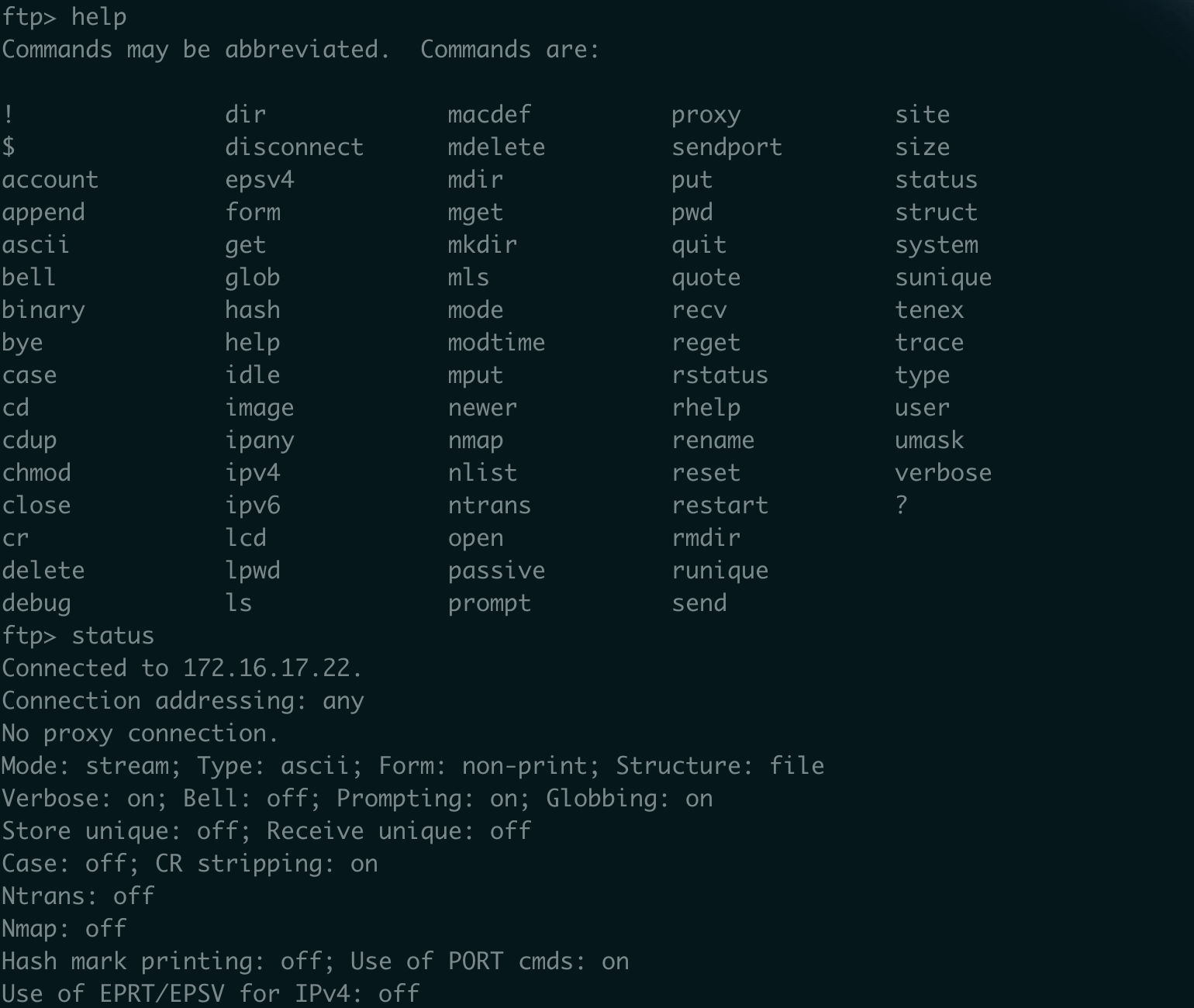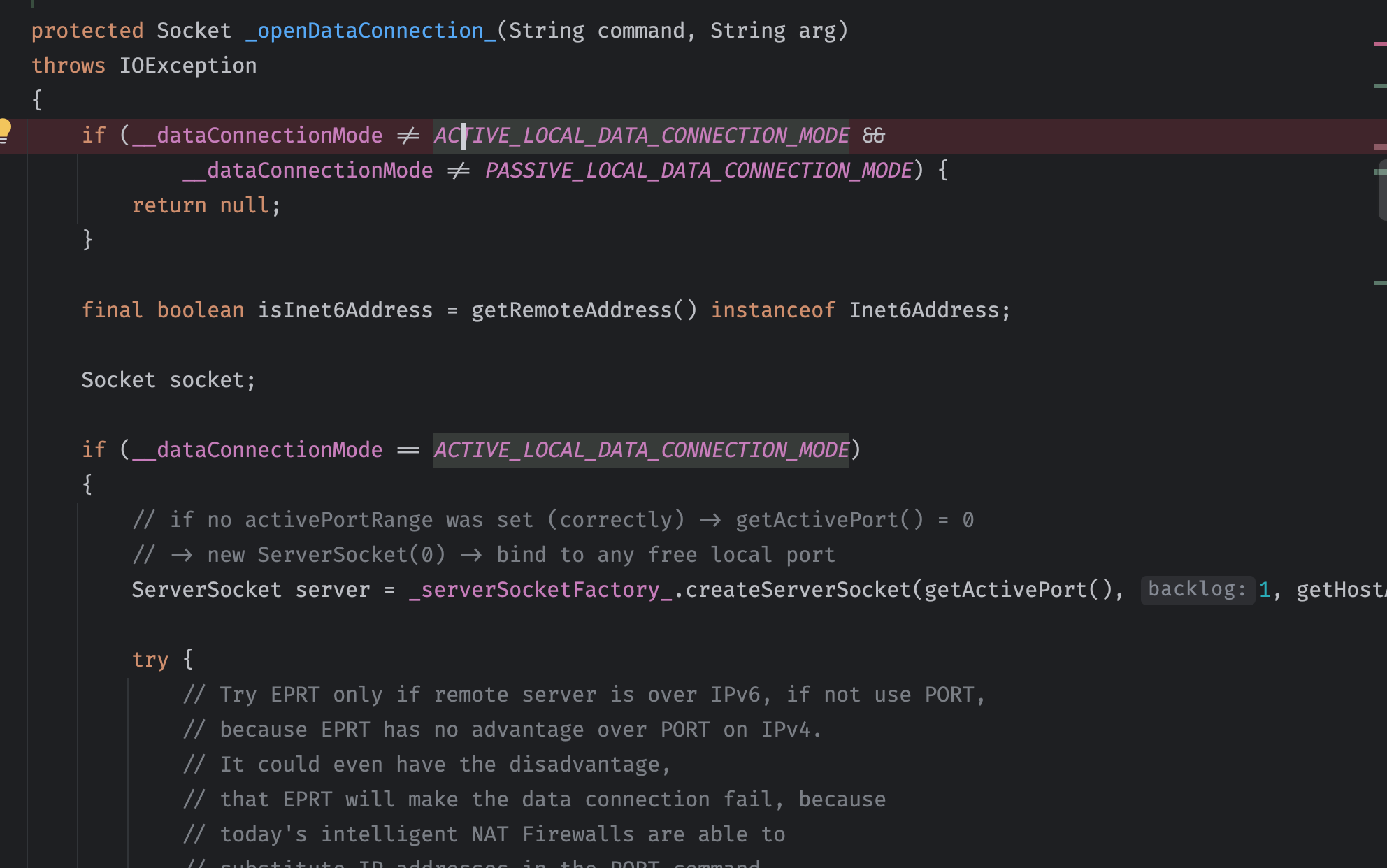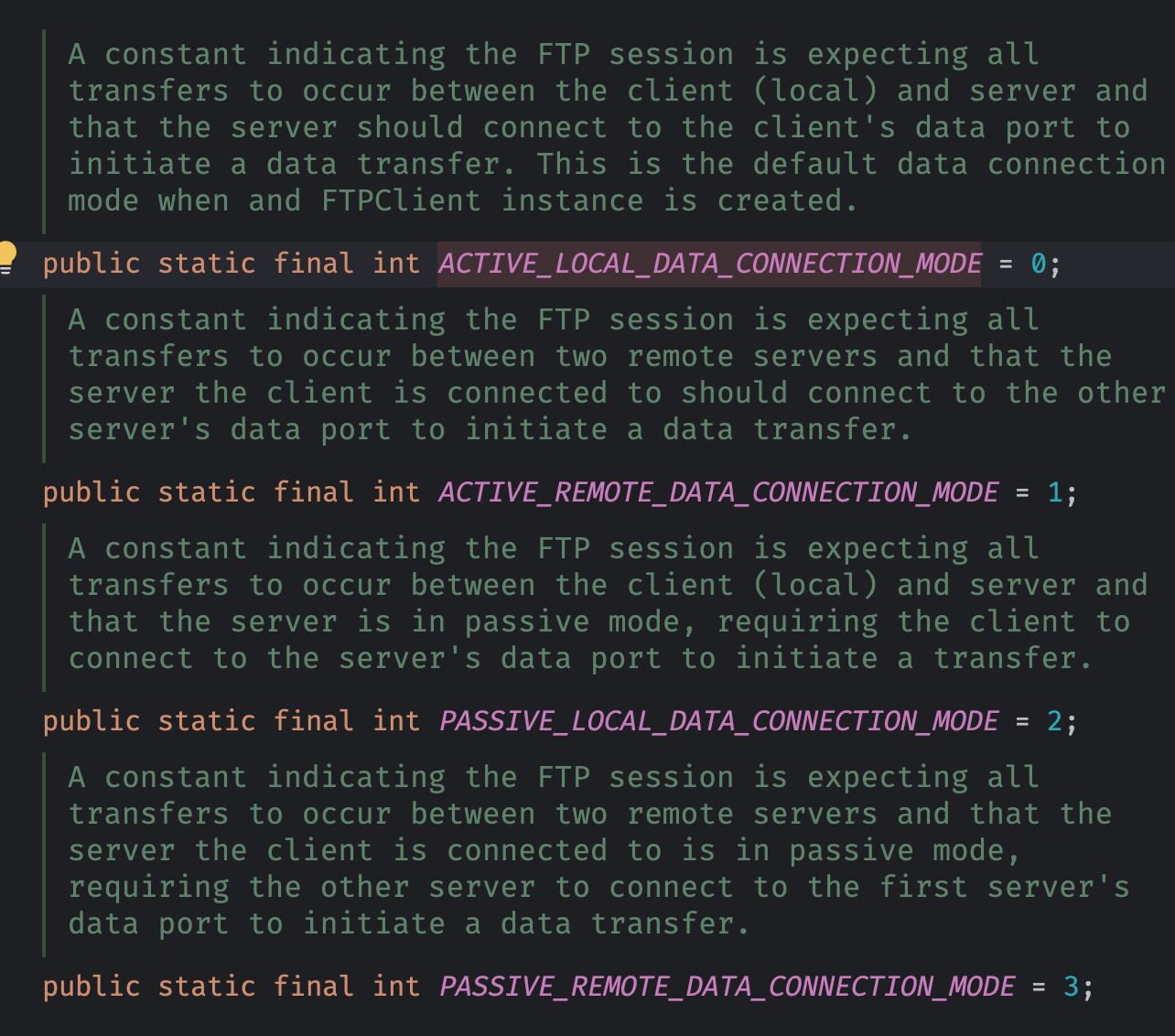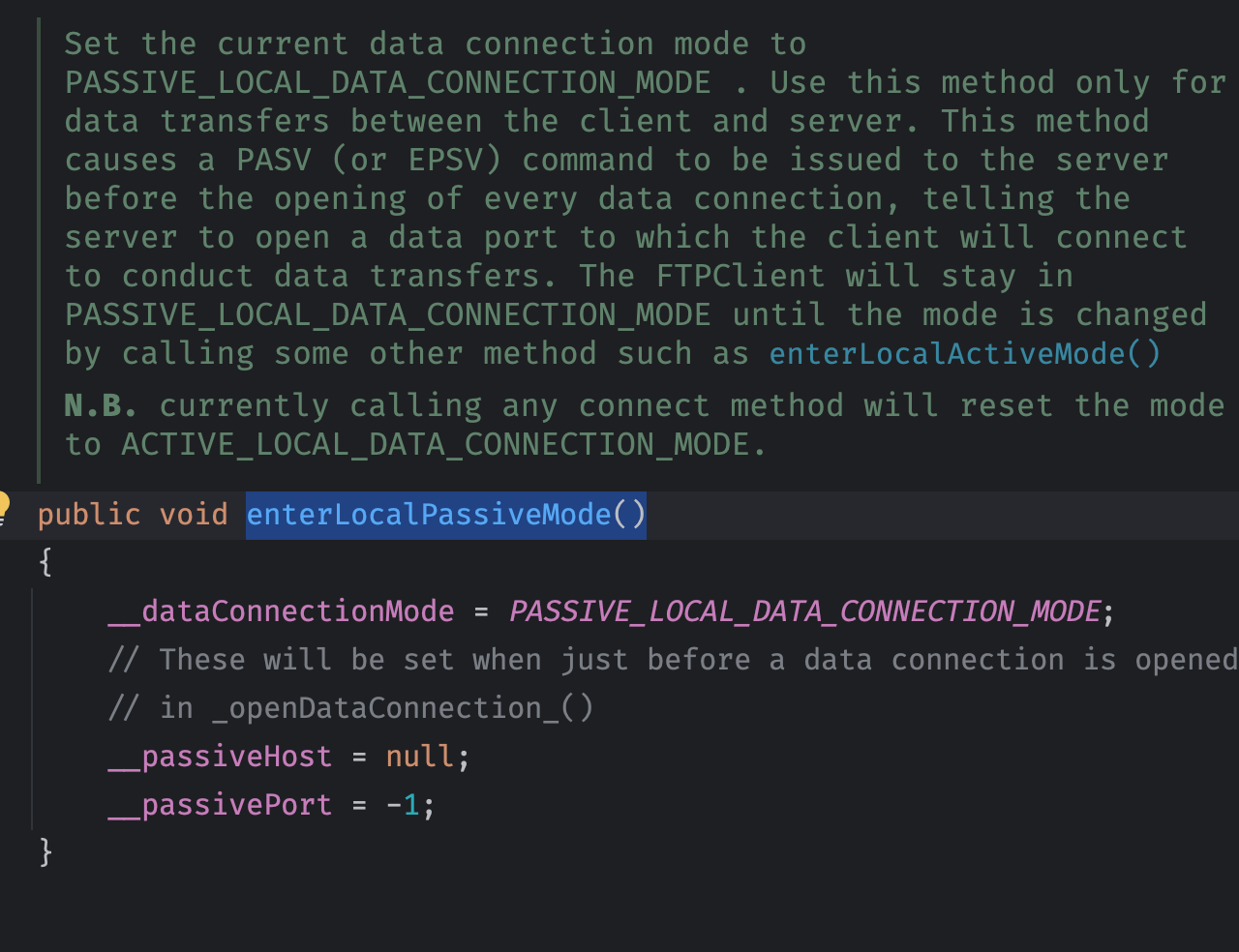起因
公司中的vsftp服务又双叒坏掉了,距离上一次调整,已经过了好久。因为上次是随便弄一下,这次想深究一下,花了一天时间。检查了一下,发现系统由于之前重装,vsftp服务没安装,导致服务无法连接。部署完成后调试了一下代码,发现客户端始终无法链接,于是使用ftp客户端进行连接和测试上传下载。期间调试更改了好些次服务配置......
issue#1 有时候可以匿名登陆,但是无法创建文件夹和文件;
issue#2 使用用户名密码输入正确但是无法登陆;
issue#3 有时候是SELINUX限制🚫不允许上传文件;
issue#4 有时候因为chroot限制和操作目录权限导致无法登陆;
issue#5 有时候因为服务器的主动/被动连接PASV模式导致可以登陆/创建文件夹但是无法上传...
(基本坑都踩完了= =)
然后通过咨询小G和服务端源码调试终于发现了端倪,最后解决了问题。特此记录一下。如果能对其他人有所帮助就最好了🌟
vsftp使用注意点介绍
- 匿名用户,可以通过服务端配置文件配置匿名用户的登录/创建目录/创建文件 权限(issue#1)
- 服务器中本身已有用户, 必须为可登录用户,否则ftp服务会登陆失败(issue#2)
- vsftp使用chroot虚拟目录技术,可以限制ftp登录用户不能访问操作主目录外的目录(issue#3/issuse#4)。
也就是说默认通过linux已有用户登录的话会直接进入其主目录,但是ftp启用chroot虚拟环境,操作的时候以/开头,例如用户名为ftpuser,主目录为/var/ftpuser,存在/var/ftpuser/test/这个路径时,在ftp客户端使用pwd以及ls命令会显示/和test。同时这里要求用户主目录的权限中不能存在写入权限如 /var/ftpuser 权限544可以,但是744不行🙅

- 主动模式和被动模式(issue#5)
在 FTP 通信中,有两种数据传输模式:主动模式(Active Mode)和被动模式(Passive Mode)。这两种模式用于在客户端和服务器之间传输文件和数据。
**主动模式(Active Mode):**
1. 客户端通过命令端口(默认是21端口)连接到服务器。
2. 客户端发送一个 PORT 命令,指定自己的 IP 地址和一个用于数据传输的端口号(通常在客户端的端口号高于1023)。
3. 服务器使用该端口来主动连接客户端的数据端口,以进行数据传输。
4. 在主动模式下,客户端监听数据连接,服务器主动连接客户端。
**被动模式(Passive Mode):**
1. 客户端通过命令端口(默认是21端口)连接到服务器。
2. 客户端发送一个 PASV 命令,请求服务器提供一个用于数据传输的端口。
3. 服务器选择一个端口并告知客户端(通过响应 PASV 命令)。
4. 客户端使用该端口来进行数据连接,服务器等待客户端的连接请求。
5. 在被动模式下,服务器监听数据连接,客户端主动连接服务器。
**区别:**
- 在主动模式下,服务器主动连接客户端的数据端口,而在被动模式下,客户端主动连接服务器的数据端口。
- 主动模式对于服务器来说比较安全,因为它可以控制连接的发起,但是可能会因为客户端的防火墙或路由器问题而无法正常工作。
- 被动模式允许客户端从防火墙或路由器后面的内部网络连接服务器,因此在许多情况下更容易设置,但在服务器上需要开放一定范围的被动端口。
大多数情况下,被动模式更容易在各种网络环境中工作,因为它避免了一些主动模式可能遇到的防火墙和网络配置问题。服务器和客户端都需要根据自己的网络环境选择合适的模式。
copy一下来自小G的回答
部署vsftp
服务端 Linux 内核版本
3.10.0-1160.71.1.el7.x86_64
操作系统版本
CentOS Linux release 7.9.2009 (Core)
vsftp服务相关命令(注意使用的服务名后面有个d,表示为后台守护进程)
yum install vsftpd # 下载安装
systemctl enable vsftpd # 设置开机启动vsftp服务
systemctl start vsftpd # 启动vsftp服务
systemctl status vsftpd # 查看vsftp服务的执行状态
# 修改配置文件后重启服务
systemctl restart vsftpd
vsftp配置,默认配置位置 /etc/vsftpd/vsftpd.conf
这个配置比较重要,vsftp服务可以扩展成集群模式使用,不过博主目前使用单点。大部分配置根据官网资料查看其功能
# Allow anonymous FTP? (Beware - allowed by default if you comment this out).
anonymous_enable=NO
#
# Uncomment this to allow local users to log in.
# When SELinux is enforcing check for SE bool ftp_home_dir
local_enable=YES
#
# Uncomment this to enable any form of FTP write command.
write_enable=YES
#
# Default umask for local users is 077. You may wish to change this to 022,
# if your users expect that (022 is used by most other ftpd's)
local_umask=022
#
# Uncomment this to allow the anonymous FTP user to upload files. This only
# has an effect if the above global write enable is activated. Also, you will
# obviously need to create a directory writable by the FTP user.
# When SELinux is enforcing check for SE bool allow_ftpd_anon_write, allow_ftpd_full_access
#anon_upload_enable=YES
#
# Uncomment this if you want the anonymous FTP user to be able to create
# new directories.
#anon_mkdir_write_enable=YES
#
# Activate directory messages - messages given to remote users when they
# go into a certain directory.
dirmessage_enable=YES
#
# Activate logging of uploads/downloads.
xferlog_enable=YES
#
# Make sure PORT transfer connections originate from port 20 (ftp-data).
connect_from_port_20=YES
#
# If you want, you can arrange for uploaded anonymous files to be owned by
# a different user. Note! Using "root" for uploaded files is not
# recommended!
#chown_uploads=YES
#chown_username=whoever
#
# You may override where the log file goes if you like. The default is shown
# below.
#xferlog_file=/var/log/xferlog
#
# If you want, you can have your log file in standard ftpd xferlog format.
# Note that the default log file location is /var/log/xferlog in this case.
xferlog_std_format=YES
#
# You may change the default value for timing out an idle session.
#idle_session_timeout=600
#
# You may change the default value for timing out a data connection.
#data_connection_timeout=120
#
# It is recommended that you define on your system a unique user which the
# ftp server can use as a totally isolated and unprivileged user.
#nopriv_user=ftpsecure
#
# Enable this and the server will recognise asynchronous ABOR requests. Not
# recommended for security (the code is non-trivial). Not enabling it,
# however, may confuse older FTP clients.
#async_abor_enable=YES
#
# By default the server will pretend to allow ASCII mode but in fact ignore
# the request. Turn on the below options to have the server actually do ASCII
# mangling on files when in ASCII mode. The vsftpd.conf(5) man page explains
# the behaviour when these options are disabled.
# Beware that on some FTP servers, ASCII support allows a denial of service
# attack (DoS) via the command "SIZE /big/file" in ASCII mode. vsftpd
# predicted this attack and has always been safe, reporting the size of the
# raw file.
# ASCII mangling is a horrible feature of the protocol.
#ascii_upload_enable=YES
#ascii_download_enable=YES
#
# You may fully customise the login banner string:
ftpd_banner=Welcome to 172.16.17.22 FTP service.
#
# You may specify a file of disallowed anonymous e-mail addresses. Apparently
# useful for combatting certain DoS attacks.
#deny_email_enable=YES
# (default follows)
#banned_email_file=/etc/vsftpd/banned_emails
#
# You may specify an explicit list of local users to chroot() to their home
# directory. If chroot_local_user is YES, then this list becomes a list of
# users to NOT chroot().
# (Warning! chroot'ing can be very dangerous. If using chroot, make sure that
# the user does not have write access to the top level directory within the
# chroot)
chroot_local_user=YES
chroot_list_enable=YES
# (default follows)
chroot_list_file=/etc/vsftpd/chroot_list
#
# You may activate the "-R" option to the builtin ls. This is disabled by
# default to avoid remote users being able to cause excessive I/O on large
# sites. However, some broken FTP clients such as "ncftp" and "mirror" assume
# the presence of the "-R" option, so there is a strong case for enabling it.
ls_recurse_enable=YES
#
# When "listen" directive is enabled, vsftpd runs in standalone mode and
# listens on IPv4 sockets. This directive cannot be used in conjunction
# with the listen_ipv6 directive.
listen=YES
#
# This directive enables listening on IPv6 sockets. By default, listening
# on the IPv6 "any" address (::) will accept connections from both IPv6
# and IPv4 clients. It is not necessary to listen on *both* IPv4 and IPv6
# sockets. If you want that (perhaps because you want to listen on specific
# addresses) then you must run two copies of vsftpd with two configuration
# files.
# Make sure, that one of the listen options is commented !!
#listen_ipv6=YES
pam_service_name=vsftpd
userlist_enable=YES
tcp_wrappers=YES
#anon_root=/home/var/var/ftp
allow_writeable_chroot=YES
# 开启pasv模式,返回端口给客户端,设置其使用的端口范围
#pasv_enable=YES
#pasv_min_port=1000
#pasv_max_port=60100
# 设置pasv模式的服务器地址
#pasv_address=172.16.17.22
# 是否显示文件目录
dirlist_enable=YES
# 配置是否输出两类日志 xferlog + vsftpd.log
dual_log_enable=YES
调试
ftp客户端调用可以连接,但是发现通过代码调用存在问题。通过ftp客户端查看服务端模式

debug时发现
// storeFileStream 始终为null
OutputStream storeFileStream = ftpClient.storeFileStream(destination);
// 深入代码发现其主动返回null的代码逻辑
if (!FTPReply.isPositiveCompletion(port(getReportHostAddress(), server.getLocalPort()))) {
return null;
}
// FTPReply.isPositiveCompletion(), 检测ftp命令的返回码结果
public static boolean isPositiveCompletion(int reply){
return (reply >= 200 && reply < 300);
}
同时注意到前面的逻辑,发现这里主要是根据连接模式进行判断


于是代码中增加了调用该函数的步骤,变更了ftp客户端连接模式为被动模式,这里是因为服务端当时设置的是被动模式(issue#5)(java这个库org.apache.commons.net.ftp 默认使用的连接模式为主动模式,即服务端主动连接客户端,服务端和客户端使用的模式需要统一)

参考资料
Q.E.D.




